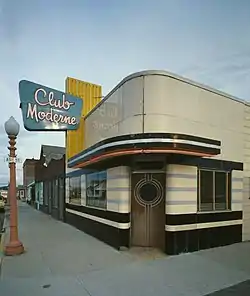Moderne architecture
Moderne architecture, also sometimes referred to as Style Moderne or simply Moderne, Jazz Age, Moderne,[1] jazz modern[2] or jazz style,[3][4] describes certain styles of architecture popular from 1925 through the 1940s. It is closely related to Art Deco.[1]

.jpg.webp)
Originating in the International Exhibition of Modern Decorative and Industrial Arts held in Paris in 1925,[1] the style has expression in styles traditionally classified as Art Deco, Streamline Moderne, Late Moderne, and, in the U.S., PWA/WPA Moderne. Architectural historian Richard Guy Wilson characterized the style by the eclectic co-existence of "traditionalism and modernism".[5]
United States
The Moderne style of architecture appears as a descriptor in documentation of many buildings listed by the United States of America's National Register of Historic Places.[6]
Streamline Moderne
Some Moderne architecture may be classified as Streamline Moderne, an evolution of Art Deco architecture which peaked in popularity c. 1937. This can refer to land-based architecture, such as the Normandie Hotel in San Juan, Puerto Rico, which show curved, shiplike forms and styling. This follows the water-based adaptation of Art Deco decorative style and architecture to passenger ships, such as the SS Normandie. Other Streamline Moderne architecture does not reflect any maritime-oriented themes.
References
- Sharp, Dennis, ed. (2002). Twentieth Century Architecture: A Visual History. Images Publishing. p. 110. ISBN 9781864700855. Retrieved 10 November 2013.
Another brand of modernism had also grown up parallel with the work of the avant-garde architects, deriving from the Paris Exhibition of Decorative Arts held in Paris in 1925. [...] Nowadays, this parallel style is referred to under the terms 'Art Deco' or 'Moderne' or 'Jazz Age Modern' [...]. [I]t gained a world-wide currency and a measure of popular success.
- Shaw, Peter (22 March 2003). "All that jazz". The Guardian. Retrieved 6 December 2022.
- "O'Connell Street" (photo + caption). State Library of South Australia. 18 June 1956. Retrieved 6 December 2022.
The buildings chevron-shaped windows are typical of the Jazz Style...
- Schenker, Marc (2 September 2021). "Design Trend Report: Jazz Style". Creative Market. Retrieved 6 December 2022.
- Wilson, Richard Guy (2002). Buildings of Virginia: Tidewater and Piedmont. Oxford University Press. p. 519.
- "National Register Information System". National Register of Historic Places. National Park Service. 13 March 2009.